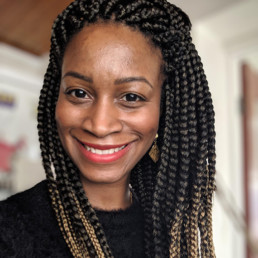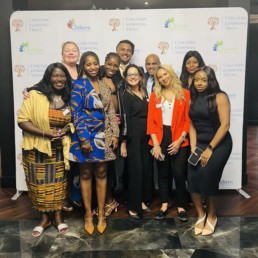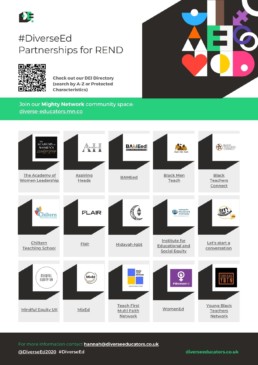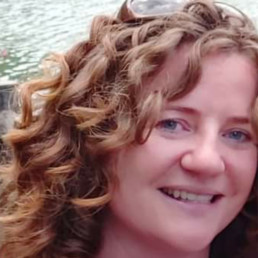Exciting changes in the English Curriculum

Written by Samantha Wharton
Samantha is a seasoned educator from East London, with ancestral roots tracing back to the Caribbean nations of Antigua and Guyana. She brings a wealth of academic achievements, including a degree in Communications and Media from Brunel University, a PGCE in English and Drama from the Institute of Education at University College London, and an MA in Black British Literature from Goldsmiths University.
English teacher Samantha Wharton takes us through some of the exciting changes to the English curriculum – featuring stories of the Windrush generation.
As well as it being the monumental milestone of 75 years since the Windrush ship docked at Tilbury forever changing the fabric of the nation; this year 2023, also marks significant changes in the English curriculum. For the first time, two playtexts by Black British female writers will feature on the English specification across three exam boards! AQA, Eduqas and OCR have added Leave Taking by Winsome Pinnock and The Princess and the Hustler by Chinonyerem Odimba to their collection of texts for examination in 2025 (available to teach THIS September).
The play Leave Taking is considerably significant in its relations to the Windrush as the writer Winsome Pinnock foreshadows some of the issues that later arise in the 2018 Scandal. The play written 1997 and produced at the National Theatre (marking the first black female playwright to have a production in this space) tells the story of Enid – a woman in her forties that arrived in England during the Windrush era. She raises her two daughter’s Viv and Del in this new British landscape where she navigates some of the challenges of being Black in Britain. I believe this is a wonderful play that documents an important story that needs to be heard. It is part of our shared British recent history. It shares the universal themes of migration, parent child relationships and belonging. It’s a text that is accessible to all GCSE students and a play that young people will relate to – especially the parent/child clashes and expectations that parents have for their children.
This is a huge change in the curriculum and one that I feel is much needed. As a teacher of 18 years I have seen many changes in the curriculum that to some extent have narrowed the world scope for young people, especially those that do not read independently. There was very little to no diversity reflected in the texts available at GCSE in particular so this is incredible. I am excited to be teaching this play at my school: St Angela’s Ursuline in London, where we will be part of a pioneering group to teach this text in the first year of official study!
I believe that diversity in literature and a range of texts help to foster a love of reading. Generally, readers like to make observations about others and escape to new places through literature. Novels are our gateway to other cultures and ways of life that we may not be able to physically be a part of. It is important that students have this exposure to different texts within the classroom and not just as part of reading for pleasure.
I was also fortunate to be commissioned by Nick Hern Books alongside Lynette Carr Armstrong to create a study guide for Leave Taking. Combined we have over 50 years of teaching experience and have created a resource that will support the learning of this text for students and will also provide a source for teacher’s planning to teach this text in the future.
I encourage teachers, parents and young people alike to engage with these stories! They are an important part of our history and need to be heard!
For access to Leave Taking (play and guide) as well as AQA conversations for teachers see the following websites:
Text: https://www.nickhernbooks.co.uk/leave-taking
Study guide:https://www.nickhernbooks.co.uk/leave-taking-gcse-student-guide
AQA: https://www.aqa.org.uk/professional-development/search?f.Themes%7CV=Spark
The Power of Networking

Written by DiverseEd
Diverse Educators started as a grassroots network in 2018 to create a space for a coherent and cohesive conversation about DEI. We have evolved into a training provider and event organiser for all things DEI.
#DiverseEd Table Photo

This Friday night we joined the team at Chiltern Learning Trust for their annual Racial Equity Network Dinner (#REND). We had been unable to make it the last two years running despite really wanting to attend and support it, but this year we were able to make it happen.
We sponsored a Diverse Educators’ table and invited some of our collaborative partners from the race section of our DEI DIrectory to join us on our table. It was brilliant to finally all be together in person! It is not very often we are in the same room, at the same time – the energy was palpable and we were very much the ‘naughty table’ as we needed to take advantage and connect whilst we could.
Thanks for joining the team from #DiverseEd:
- Nadine from Aspiring Heads
- Rhia from Black Teachers Connect
- Jemma from Let’s Start a Conversation Today
- Aretha and Youlande from Mindful Equity
- Louise and Marcus from MixEd
Getting to Luton for 6pm on a Friday night, at the end of a long year and a hard term, was not for the faint-hearted. Our table travelled from Manchester, Nottingham, Birmingham, Watford, London, Kent, the New Forest and Bath to attend the event. The journey to the event is very much a metaphor for the direction of travel of the work – it is non-linear, frustratingly slow and there are lots of obstacles to navigate including poor conditions and route closures.
We were delighted to be in the room where it was happening, along with 480 other attendees, who all care about and are committed to affecting change when it comes to racial equity in the education system. We had a lot of other connections and collaborative partners at the event including:
- Diana from the Academy of Women Leaders
- Frankie from BAMEed SEND
- Albert and Johnoi from Black Men Teach
- Iona and Sam from Edurio
- Daryl from Flair
- Paul and Andrea from the Institute for Educational and Social Equity
- Penny from The Linking Network
- Bukky, Flora, Yamina, Kiran and Emma from #WomenEd
In the more formal part of the event before the eating and networking started, there were a series of short presentations from a range of speakers:
- Sufian Sadiq – shared a heartfelt reflection on the fatigue and frustration of how slow the rate of change in this work is for him, his peers and his family. His call to action was for solidarity.
- Professor Paul Miller – shared the systemic data to highlight the structural and societal barriers for people of colour in our sector. His call to action was for allies to leverage their power.
- Sarah Owen MP – shared a personal narrative of being a biracial pupil and how this work could have helped her journey as a pupil but also now as a politician. Her call to action was to create greater belonging.
- Dr Patrice Evans – shared a quote from Obama and reflected on her journey being the only black woman in many spaces. Her call to action was to collect the stones and to use them to build empires.
- Hannah Wilson – shared her awareness of being a white person speaking to a room of global majority and then used the space to amplify the organisations in the room doing brilliant work in this space. Her call to action was to join the coalition.
- Assistant Professor Derron Wallace – shared a comparative lens to the data and the activity in the US compared to the UK and questioned what our collective strategy for racial equity is. His call to action was that everyone needs to own the role they have to play.
In the less formal part of the evening it was great to see, chat to and smile across the room at Alison from CCT, Mary from Myatt and Co, Tom from Ambition School Leadership, Phillippa and Sajid from PACT, David and Ena from Venturers Trust, James and Sharon from Inclusive MAT, Antonia and Bhamini from Pioneer Educational Trust, Adam from OTSA, Thahmina and Omar from CST, amongst others.
#REND is a brilliant example for the power of networking. The event was a magnet for people seeking a shared vision, a unified purpose, a collective agency. Together we are stronger, and we can go further.
Do check out the social media posts via the event hashtag #REND and put the draft date for the 2024 #REND event in your diaries: Friday 12th July. We will have a table there again and will invite new partners from our DEI Directory to join us. It would be great to see you there and they are increasing capacity to 600 for next year’s event.
DEI Directory Flyer

Pupil Voice and Agency – DEI Pupil Leaders

Written by Kiran Satti
Senior Assistant Principal; Primary Trust - Literacy Lead Practitioner; #WomenEd Regional Leader; Contributor to Diverse Educators: A Manifesto.
Diversity, Equity and Inclusion – what does it mean to the children we serve in our school communities?
One of our DEI Pupil Leaders shares what it means to her…
I am very proud of being a DEI leader because it is an important job. It is important because we are helping the children learn about the Protected Characteristics, we are reading important stories to the children to help them become aware and most importantly, help the children understand what it might be like for someone living with some of these Characteristics, such as disability.
The stories she is referring to are our DEI Story Escapes. At the beginning of this year, the newly formed DEI Pupil Leaders (another branch to our Pupil Leadership Team) sat and discussed which books they believed were best representative of each of the Protected Characteristics. Most powerfully, this group of Pupil Leaders were representative of the increasingly diverse learning community they are part of. The DEI Pupil Team have 6 members who are very passionate about equal and human rights – this was evident when I was sharing the Pupil Training, where we learnt about the Protected Characteristics and the importance of understanding intersectionality.
In alignment with the Pupil Training, I also delivered staff training to ensure the teachers and educators shared the same understanding of DEI as the Pupil Leaders. It was important everyone in our school community had a shared language and understanding to draw from as the children started to read the DEI Story escapes to the classes.
Here are some of the Pupil Leader’s favourite DEI Story Escapes:
My favourite DEI Story Escape we have shared so far is There is a Tiger in the garden! There is a tiger in my garden is my favourite book because it has amazing illustrations and lots of emotive language. “Wow!” says Nora is my favourite part of this book because of how beautiful the dragonflies were and how they drew them! This book is about the protected characteristic AGE – it doesn’t matter what your age is, we can all still use our imagination, young or old.
My favourite DEI Story Escape is Pink is for Boys. My favourite page is where blue is for girls and pink is for boys. Ut is my favourite book because it tells us that colours are for everyone – they are not gendered. There are no colours for particular people – all colours are meant for everyone.
Pink is for Boys is my favourite book because it shows us thar all of the colours are for everyone. My favourite pages are the ones with the unform and where it says pink is for girls and boys.
Sulwe is my favourite DEI Story Escape. It is my favourite book because at first she thought she wasn’t pretty because she wasn’t the same skin colour as her sister but then she realised people needed the darkness to rest – my favourite page is where they told her, “When you are the darkest is when you are most beautiful.”
The DEI Story escapes have been an incredible success, mostly because the Pupil Leaders have read and led the discussions. Pupil Voice is at the heart of our DEI work at Wallbrook Primary Academy because they are the future – the pupils are being enabled to use language which is instrumental to creating a future that accepts and nurtures differences.
Developing the power of story, the Pupil Leaders are currently sharing Braille stories with their peers. They lead on teaching their peers how to decode using Braille, and have developed several games to enable the children to learn and practise reading and writing in Braille.
I can not wait to see how DEI continues to grow and the DEI Pupil Leaders continue to flourish into the next academic year!
An Exploration of the Persisting Legacy of Imperial Rhetoric in Modern Education through a Case Study on ‘Eugenics, Race, and Psychiatry in the Cape Colony, 1890-1908: Dr Thomas Duncan Greenlees’

Written by Rosa Legeno-Bell
Rosa is co-founder and Director of Diverse History UK (DHUK); an LGBTQ+ and female-owned business. DHUK provides educational consultancy to address diversification of educational curricula. Rosa has worked in the education sector for over a decade, mainly in inner-city London comprehensives; as a History Teacher, Head of History and Associate Assistant Principal. Rosa graduated with distinction from the University of East Anglia with a Master’s Degree in Modern History.
This blog examines imperial rhetoric around race and eugenics through a case study of colonial psychiatrist Dr Duncan T Greenlees and explores how the legacy of imperialism lives on in the education sector.
Greenlees was the medical superintendent of Grahamstown Asylum in the Cape Colony from 1890–1907, regarded by his peers as an authority on race and eugenics (T. Duncan Greenlees M.D., 1930).
Greenlees’ Theories on the Native Mind
‘[African natives’]… wants are simple and their habits primitive; they are… willing servants, and naturally look up to white people…’ (Greenlees, 1882)
Greenlees maintained that biological and cultural differences between Africans and Europeans explained native mindsets. He attributed native ‘insanity’ to the exposure of ‘savage’ minds to Western civilisation (Swartz, 1995). The myth of primitive natives was key to the justification of British paternalism in the colonies as well as the confinement of natives who refused to conform to their prescribed roles in colonial society (Summers, 2010). In A Statistical Contribution to the Pathology of Insanity (1902), Greenlees declared that:
‘…[if] brought under the artificial influences of civilisation…[the native] …is particularly liable to chest troubles.’
And also claimed:
‘While mania is considered a disease of undeveloped [native] brains, melancholia may be regarded as one of developed [European] brains’
(Greenlees 1902, p. 12).
The falsity that non-whites were incapable of melancholia was supported by later colonial psychiatrists and is still echoed in practice today (Rosenberg, 2019). Greenlees also appealed to the common myth of the unhygienic native, stating they are ‘extremely filthy in habits,’ (Greenlees, 1902. p. 17) a stereotype commonly used to underpin dehumanising imperial rhetoric.
The influence on Greenlees of Victorian hegemony, such as Darwin’s theory of natural selection, is discernible. Darwin’s theory was commonly misapplied by imperialists to claim racial superiority and, under the guise of Social Darwinism, to justify imperial actions (Dafler, 2005). In Insanity Among the Natives of South Africa Greenlees warns:
‘The time will soon come when civilisation will overshadow [native tribes] with its baneful pall, bringing innumerable diseases in its train and ultimately exterminating all races that oppose its progress.’
(Greenlees, 1895, p. 75)
Greenlees’ Principles of Eugenics
‘…how much suffering might be avoided if…men were allowed to exercise the same care in the selection of their mates as they do when breeding their cattle’
(Greenlees, 1892, p. 302).
During the Nineteenth Century, white-working class British people were also dehumanised and infantalised by the British state. The white working classes were integral to imperial rule as they powered the industrial revolution on home soil through cheap labour and terrible working conditions.
Greenlees worked in the Cape Colony after the emancipation of Transatlantic slaves and during the Second Boer War (Facing History and Ourselves, 2018). At this time, it was believed that many South African whites, particularly Afrikaans, were becoming less civilised, mirroring British stereotypes of native peoples (Klausen, 1997). For Greenlees it was paramount that the white race maintained an air of supremacy. (Burdett, 2014), He argued that the breeding of ‘lunatics,’ ‘imbeciles’ and ‘drunks,’ constituted a grave threat to imperial rule (Klausen, 1997).
Greenlees’ also theorised about ‘coloured’ (mixed-raced) people, referring to them as ‘the bastard.’ Highlighting his fears regarding race and degeneracy, he contended:
‘a mixture of white and black blood… seems to present the worst characteristics of both races.’ (Greenlees,1892, p. 71)
Greenlees opined that, mixed-race communities were degenerates and threatened British dominance (Kolsky, 2013), a view mirrored by segregationists in the southern states of America around the same time.
So, Greenlees advocated for people to make genetically ‘wise’ choices over their marriage partners and proclaimed that it is:
‘…absurd… that we should devote more…consideration to the mating of our horses and pigs than we do that of our sons and daughters’ (Greenlees, 1903, p. 11).
The Impact of Colonial Rhetoric around race and class on the Current Education System
‘… decolonising and detoxifying the education regime are a sine qua non for… academics, especially those who are cognisant of the true meaning of education.’
(Nkwazi Nkuzi Mhango, 2018)
Elhinnawy (2022) maintains that a diverse book collection does not suffice and that educators need to honestly explore their own internal prejudices and their origins. While Bentrovato (2018) contends that colonialism is a ‘hallmark of modern world history.’ whose legacies survive because of modern institutions such as education.
But, decolonisation has been controversial. Seemingly concerned, The Department for Education (2022), introduced a guidance on impartiality in schools in 2022 on the back of the growing call to decolonise education.But decolonisation is possible still, as the guidance does not include any additional statutory requirements, and there is still room to decolonise if a range of historical evidence is engaged with and views are not taught as objective fact. The dichotomy between a government and its institutions can cause friction. Leading governmental leadership posts are filled disproportionately by privately educated people (predominantly white and male) who attended Oxbridge colleges. In 2019, 57% of the government’s cabinet and 36% of those who work in the media had attended an Oxbridge university (The Sutton Trust, 2019). Notably, private schools and Oxbridge universities were avid mouthpieces for colonial rhetoric.
Despite the controversy over decolonisation, it is a no-brainer. As diversity increases, decolonisation becomes more urgent –with 43% of young Black people saying that:
‘A lack of curriculum diversity was one of the biggest barriers to…achieving in schools,’(Anna Freud, 2021).
Yet many schools still pursue whitewashed curricula and old-fashioned pedagogies. Critics of decolonisation have argued against it on the basis that we should not eradicate history, but true decolonisation does not entail deleting history, it encourages adding to existing narratives and amplifying historically silenced voices. Another criticism is that decolonisation only considers marginalised black voices, but that is too literal an understanding. Decolonisation believes in amplifying all marginalised voices such as the white working classes who too were downtrodden and exploited for the empire. One compelling reason for decolonisation is that the amplification of many voices and celebration of shared histories may also repair relationships between marginalised communities, too often pitted against each other.
Greenlees provides a significant insight into the ideologies that propped up the British empire, and serve as a shocking reminder of the philosophies on which modern Britain was founded. If educators work together to build a fairer education for our students, then we are playing a part in creating a kinder and more compassionate society for our students and our children.
Read more and find the references here:
Teach First and diversity in the teaching workforce

Written by Jenny Griffiths
Jenny is Teach First’s Research and Knowledge Manager. She is an expert in research related to teacher development and educational inequality, with a particular interest in understanding teacher retention. Prior to working at Teach First, Jenny achieved a BA (Hons) and MPhil from the University of Cambridge, and an MSc from Birkbeck, University of London. She taught History and Sociology and was a Head of Department in London schools for nearly a decade.
The proportion of postgraduate trainees reporting their ethnic group as belonging to an ethnic minority, has increased from 14% in 2015/16 to 22% in 2022/23 (UK Government, 2023). This is similar to the diversity of the working age population (21.8%) (UK Government, 2023). However, research by the National Foundation for Educational Research (NFER) shows that 60% of schools in England have no teachers from ethnic backgrounds other than white, and pupils – 35.7% of whom are from a minority ethnic background – are less likely to encounter teachers from black, mixed or other ethnic backgrounds (NFER, 2022). In fact, a significant number of the pupils in of schools will have no experience of a Black teacher throughout their time in school (Tereshchenko, Mills & Bradbury, 2020). We believe that this lack of representation, particularly in STEM (science, technology, engineering, maths) subjects, may make it harder for young Black pupils to engage with these subjects and pursue related careers.
Over the past 20 years Teach First have screened approximately 120,000 applications and assessed over 50,000 candidates for a place on our training programme. We are committed to increasing diversity in the teaching workforce and we’ve learnt a lot about how to root out bias in our application and assessment process, but we are committed to continuing to learn and improve.
As part of that work, along with Ambition Institute, we supported the NFER to carry out research looking at racial equality in the teacher workforce. This research showed that the most significant ethnic disparities are seen at the early stages of teacher’s careers, starting with ethnic minority people being over-represented among teaching applicants, but having a lower acceptance rate compared to other groups. We are pleased that Teach First are the only ITT provider where an ethnic minority group, those of mixed ethnicity backgrounds, has the highest acceptance rates. We also have less disparity in acceptance rates between ethnic groups than other providers, but we are continuing to work to reduce this gap still further (NFER, 2022).
Our recruitment strategy is designed to identify potential and reduce the risk of bias in our decisions, first by removing personal details in applications. The most significant change however was the introduction of contextual recruitment at the application stage. This allows us to take greater account of the different backgrounds of applicants in order to attempt to offset the impact of socioeconomic disadvantage. Applicants complete a short survey about the type of school they attended, whether they were eligible for free school meals, socioeconomic background and any significant disruption such as time in care, refugee status, or being a young carer. Whilst applicants must demonstrate clear evidence of our competencies, this screening helps us to understand where grades that are lower than our traditional entry level requirements are not necessarily reflective of potential. This approach has led to a 15% increase in offers to join the training programme overall and Black, Asian and Ethnic minority representation increase from 12% in 2017, to 18% in 2018 (after the introduction of contextual recruitment), and to 22% in 2019 with changes to our selection day processes.
This improvement notwithstanding, we know there remain particular challenges in attracting Black and other underrepresented groups into teaching, especially in STEM subjects. To address this we are working in partnership with Mission 44 to recruit and train Black STEM teachers to work in schools serving disadvantaged communities in England. Our initial research specifically looked at how to attract more STEM graduates from Black and mixed Black ethnic backgrounds into the teaching profession. Motivation to enter teaching varies individually, but also differs between social groups. A discrete choice experiment enabled us to test elements of our programme where we felt changes might have the biggest impact on recruitment.
What we found was that Black and mixed Black STEM graduates saw salary as being of high importance. We also found that location mattered: respondents indicated a clear preference for a guaranteed placement in London or within 60 minutes of their home address. Perhaps more interesting in terms of understanding changing work and lifestyle priorities, was the interest in lifestyle benefits, such as restaurant or gym discounts, as being likely to motivate more graduates to apply. Focus groups elaborated on some of these responses, indicating the importance of financial and societal pressures in decision making. In teaching where starting salaries are perceived to be relatively low, the importance of career progression was clear. Another finding central to our understanding and future work, was the concern of Black graduates about the level of diversity and inclusion in the schools where they would be working. There was a wariness of being in a school with an exclusively White teaching workforce, and despite clear desire to be a positive role model, these concerns posed a perceived risk to their wellbeing which needs to be addressed if we want to address ethnic inequalities in the teacher workforce in a sustainable manner.
You can download our report on this work to read the findings from the research in full and the recommendations proposed.
Despite some gains, we know that disparity remains and we remain committed to reviewing, re-evaluating and improving our practices to support diversity and inclusion in our education system, for teachers, schools and pupils.
Pride Matters: 5 actions for inclusion and quality for leaders

Written by David Weston
Co-CEO of Teacher Development Trust; Chair DfE CPD group; author, campaigner and speaker.
The annual month of pride comes around and it can be a difficult one for school and system leaders to tackle. The will is there, so what’s the best way? How can LGBTQ+ inclusivity be approached effectively and sensitively with staff, and with children and young adults?
In this article, David Weston, Teacher Development Trust’s co-CEO (Innovation & Research), draws on his experience as a founder of an LGBTQ+ teacher community, a trainer for LGBTQ+ school leaders and as a campaigner for LGBTQ+ rights. TDT is a national charity that supports schools to tap into the power of school improvement through people development, inclusive of all.
It’s worth reflecting first that while parties and celebrations are often the visible part, this month is an annual moment to focus all of humanity’s mind on what we still need to do to remove barriers, decrease inequality and create greater inclusion for all people who fit under the LGBTQ+’s broad rainbow. Even here in the UK, pride matters:
- Because countless LGBTQ+ individuals are still subjected to conversion therapies that attempt to erase their identity, and the government’s promises to deal with this remain unfulfilled.
- Because LGBTQ+ children are much less likely to receive proper relationship and sex education that helps them navigate their lives
- Because many LGBTQ+ youth are at a higher risk of homelessness due to family rejection.
- Because LGBTQ+ people often face discrimination in healthcare, leading to worse health outcomes.
- Because transgender individuals are often denied their right to self-identify and face additional barriers in accessing legal and medical support.
- Because LGBTQ+ individuals still face significant barriers in the workforce, including wage gaps and discrimination.
- Because LGBTQ+ history is often overlooked or omitted in education, leaving many unaware of the community’s contributions, rich heritage and ongoing struggles.
- Because suicide rates among LGBTQ+ youth are disproportionately high, which speaks to the urgent need for societal acceptance and support.
- Because many countries around the world still criminalise homosexuality, and LGBTQ+ individuals face persecution and violence, whether as citizens or even as visitors.
There has, of course, been a huge amount to celebrate as well. Pride marches and celebrations now are also a joyful and colourful reminder of the progress made. The ability to legally live freely, to love who you want, to marry, to have children – all these things represent such extraordinary progress. But no matter how far things have come, there are always hurdles that others won’t face. The emerging sense through childhood of feeling different, the attitudes of some groups and traditions that range from making LGBTQ+ people feel unwelcome all the way to genuine fear for their lives.
As a leader, making sure that staff and young people feel included is not just a moral imperative, it has genuine advantages. When adults or children feel afraid to be honest about their lives, constantly policing how they look, what they say or how they react in case they give something away, it affects their performance, their learning, their wellbeing. When workplaces and classrooms feel inclusive, open, with a celebration of difference, it allows everyone to give their best.
Here’s 5 actions that every leader can take:
- Policy Review and Implementation: School leaders should ensure that policies are inclusive of LGBTQ+ people. This includes anti-bullying policies, codes of conduct, dress codes, and any other rules or regulations. It should include the way that the school recruits and supports staff and pupils. These policies should explicitly mention protections for LGBTQ+ individuals and should be enforced consistently.
- Staff Training: Provide regular training for all staff on LGBTQ+ issues, ensuring they understand the importance of inclusive language, the challenges that LGBTQ+ students and staff may face, and how to address discriminatory behaviour. This knowledge will help them to create a more supportive environment for LGBTQ+ students and staff.
- Student & Staff Support Services: Establish or strengthen support services for LGBTQ+ staff and students. This could include setting up an LGBTQ+ Alliance (or similar group), providing counselling services with counsellors who are trained in LGBTQ+ issues, and ensuring that health and sex education classes are inclusive of LGBTQ+ experiences.
- Promote Visibility and Awareness: Celebrate LGBTQ+ History Month, participate in Pride events, and integrate LGBTQ+ history and contemporary issues into the curriculum. This helps to normalise LGBTQ+ identities and experiences and can contribute to a more inclusive school culture.
- Engage with the Wider Community: School leaders should communicate with parents, carers and the wider community about the school’s commitment to LGBTQ+ inclusion. This can help to build a supportive environment not only within the school but also in the students’ lives outside of school.
Together, we learn and we evolve. If you would like to explore how TDT can help your school or trust to embed a thriving, research led culture of professional development that sticks, please get in touch.
Footnote:
LGBTQ+ is an umbrella acronym that includes people who identify as Lesbian, Gay, Bisexual, Trans*, Queer (or sometime Questioning) and the plus indicates that it encompasses all other related communities around gender and sexuality, including those who are Intersex, Non-binary, Asexual, Aromantic, Pansexual and more.
Addressing the Legacy of Section 28 & Supporting Diverse Families

Written by Troy Jenkinson
Equality, Diversity & Inclusion Specialist, children’s author, public speaker and former Primary Headteacher and Executive Headteacher. https://troyjenkinson.com/
Today, more than ever, we should strive for equality in our schools. Seeing how LGBTQ+ culture has been embraced in colourful Pride events and the peppering of queer characters in the media, you could be forgiven for thinking we had turned a corner in equality. We have come a long way, triumphing over the Section 28 policy (the 1988 amendment to the UK Educational Bill silencing queer teachers) and the partial decriminalisation of homosexuality. We have fought hard for rights to marry, adopt and live our lives showing our “True Colors” to quote Cyndi Lauper.
Digging deeper, you realise how far we still need to go. The ILGA (2020) reports 70 countries still criminalise homosexuality; 6 punishable by death, 57 with lengthy prison sentences. Only 68 countries offer broad protection for their LGBTQ+ population. High profile media events point to continued educational need. Florida’s “Don’t Say Gay” Bill (March 2022) mirror’s Thatcher’s vindictive 1988 Section 28. We have not learned. Cripplingly unfair acts such as harsh laws to imprison LGBTQ+ people for life in Uganda reported by the BBC in March 2023 marginalise our community.
The UK once topped the ILGA table of European countries for LGBTQ rights (2015), but slumped 14 places by 2022, accredited to governmental failures and its abandonment of its promise on gender recognition and equality plans. The statistics speak for themselves. Galop (2021) reported “LGBT+ hate crime is disproportionately on the rise in the UK.” Two thirds of LGBTQ+ people experienced homophobic violence or abuse. This likelihood only increases for ethnic minority and trans people.
The question we have to ask ourselves is; why?
Bullying is borne from ignorance. Section 28 has long-lasting effects on our educational establishments. Stonewall reports LGBTQ+ students are twice as likely to have been bullied than their non-queer compatriots (42% compared to 21%). Teachers echo this; 85% of secondary and 45% of primary staff acknowledge homophobic bullying in their schools.
With less than half of LGBTQ+ students (48%) experiencing positive messaging to support them, it is high time we as educationalists did something about it. The government introduced Relationships and Sex Education Guidance (2019) but left it open to interpretation stating:
“Schools should ensure that all of their teaching is sensitive and age appropriate in approach and content. At the point at which schools consider it appropriate to teach their pupils about LGBT, they should ensure that this content is fully integrated into their programmes of study for this area of the curriculum rather than delivered as a standalone unit or lesson. Schools are free to determine how they do this, and we expect all pupils to have been taught LGBT content at a timely point as part of this area of the curriculum.” (DfE, 2019)
Robert Long (2023), concludes schools are still not required to “promote” same-sex marriage:
“Governors, teachers and non-teaching staff in schools, parents and pupils, are free to hold their own religious or philosophical beliefs about marriage of same sex couples.” (Long, 2023)
Schools need help to sensitively support all pupils and tackle the endemic victimisation. They need to address inequality and inclusion in their curriculum and how they support diverse families. There is little guidance for parents themselves.
From my own experience of coming out, my parents found it traumatic; relating it to grieving as they tackled a myriad of questions, hyped by media negativity:
- Would I grow up happy and fulfilled?
- Would I be bullied?
- Would I die of a terrible disease?
- Would they have grandchildren?
Though this was in the 2000s, it is still a very real issue for some individuals today.
Recently, I worked with international colleges supporting staff and students from countries with poor human rights for LGBTQ+ citizens. I became fascinated by the term “Straight Privilege.” Those not identifying as LGBTQ+ do not have to come out, or seek out role models in the public eye. It is an interesting concept to explore.
As a headteacher, influenced by Andrew Moffatt, I introduced weekly “No Outsiders Assemblies.” Using news images, I positively identified people who stood up for their rights or succeeded despite potential marginalisation. This ranged from Malorie Blackman’s interpretation of historical figure, Rosa Parks for Doctor Who and Jacinda Ardern’s maternity arrangements as New Zealand’s Prime Minister, to discussing the controversies of a gay kiss at the 2018 Winter Olympics.
Working with a family whose children experienced bullying for having same sex parents, inspired me to publish my first children’s book “The Best Mummy Snails in the Whole Wide World.” Since, I have delivered countless assemblies, workshops and key notes speeches aimed at fighting the corner and being the role-model, I never had in school.
What Does it Mean to Belong?

Written by Hannah Wilson
Founder of Diverse Educators
Some people think that framing DEI work under belonging softens it and dilutes it, whilst I do understand this critique, I personally believe that belonging is the door-opener to the conversations about DEI, it is the way-in for many to enter the space.
Belonging to me is being seen, being heard, being valued, being safe. Belonging is not about fitting in but about being accepted, loved and respected for who we are. When we belong, we feel included, we feel connected and we can flourish as we can be ourselves without fear of judgment. We belong when noone makes us feel like an outsider, noone others us. We belong when we are celebrated, not tolerated.
I always start my training session with any stakeholder group by exploring the language and unpacking the acronyms that can inhibit the work. I share the linguistic/ acronym journey of DI (Diversity and Inclusion) becoming EDI (Equality, Diversity and Inclusion) and iterating into DEI (Diversity, Equity and Inclusion). With the J for Social Justice appearing with some saying DEIJ and others saying JEDI. Noticeably, the addition of the B has been a more recent trend in the last 3 years.
Belonging appeared in our consciousness and in our vocabulary in the wake of George Floyd’s murder. As we saw corporate commitments to doing the work, I observed a trend on LinkedIn. People in my network who were Heads of DI/ EDI/ DEI were becoming Heads of Belonging. A subtle shift in language which reframed their role. Their remit was to be responsible for levels of belonging in their organisation and to use this lens to scrutinise policies, processes and practices.
I started sharing this observation with the school people I was training and it always resonated – show me an educator who would answer No to the question: Do you want all of your learners to belong in your classroom/ school? In some ways it is a bit of a trick question when you then follow up with more probing questions about belonging in the curriculum and in the library. They have already said Yes so how do they now do a U-turn and say No?
I began to extend the questioning to the adult experience: Which adults belong in your school? Which parents belong in your playground? Who belongs in our education system? Each question was a provocation to invite some reflection and discussion, to shift people out of their own bubbles and to exercise some awareness and some empathy for others.
Using my coaching skills to create a safe space, to take people beyond their comfort levels and to increase their consciousness is a facilitation strategy I am constantly refining. A safe space means that we can be courageous and that we can challenge one another but that we do it in a mindful way. The wheel of power of privilege exercise I regularly use is a tool that can create high levels of discomfort but it is a great way to unpack the ‘perception gap’ and emphasise why some people might have a greater sense of belonging than others.
Linking the census data for the country to the workforce census for our profession to attrition data for the sector to hate crime data in society to staff and student survey data, is another way to increase awareness of who belongs and why this might be. As an English teacher I use the data to tell the story of a space and I ask the question: What story is the data telling us about who belongs here?
So when I am delivering keynotes and workshops on Creating a Culture of Belonging, with the acute awareness that I am a cis-het, white, able-bodied woman who is facilitating the conversation, I am not letting people off of the hook, but I am instead creating a container for some radical candor. I am holding up the mirror to myself and to others to recognise that we might have taken our own sense of belonging for granted and that we might assume that others feel/ experience our spaces in the same way as we do, when the reality is that there are gaps which can quickly become gulfs.
I remind people in our training sessions that belonging and love are at the centre of Maslow’s hierarchy of needs. Noone can progress to the upper tiers of esteem or self-actualisation without a sense of connection. More importantly it is also a reminder that we do not belong if our physiological and safety needs are not being met. A stark example of this is found in the Just Like Us 2021 Report – Growing Up LGBTQ+ published as we came out of lockdown.
Belonging is the goal of our DEI work. Belonging is also the outcome of our DEI work. Belonging surveys can be helpful as they baseline how people are currently feeling about their experience – we can baseline and benchmark belonging by role, by group, by identity and listen to/ learn from what we are being told. Belonging is not fluffy, when used intentionally, it instead creates insight from the different portals it opens up for us to explore.
For example, women between 30-39 who are parents/ carers and who are seeking flexible working vote with their feet and leave our sector in droves each year. How can we create more family-friendly schools to create a greater sense of belonging for that group of professionals?
For example, mixed race is the fasting growing racial identity in primary school pupils nationally. How can we recruit and retain more teachers of colour who represent the communities that we serve? How does having increased role models in the staff increase the levels of belonging for our pupils?
A culture of belonging is one where we are courageous and curious, one where we are open to challenge and committed to change. It is one where we ask searching questions and where we listen to the often hard truths that are revealed.
So as everyone jumps on the ‘Belonging Bandwagon’ and it becomes the newest buzz word at edu-events, can we make sure we are not skirting around DEI issues but getting to the heart of the matter? And when we are talking about belonging at events and in our schools can we be more aware of who is in the room, of who is talking, of who is listening and what that also tells us about the sense of belonging or the lack of?
5 Ways to Imbed Inclusion and Diversity in EYFS Lessons

Written by Jess Gosling
An experienced international Early Years teacher, blogger and writer. She is currently writing a book for international teachers, 'Becoming an International Teacher'.
I am currently in my ninth year as an international teacher, and this article was written when I was working in a school with mostly local children in Taiwan. The problem I aimed to solve then was how to showcase and embed diversity and inclusion into our classroom environment.
Therefore, I have developed, and continue to develop here in Poland, a series of ways to bring up issues of diversity, gender, disability, and culture in a way that is relevant, informative, and engaging.
These are big topics for EYFS pupils but there are ways to bring them up organically alongside other areas of learning – often using texts to help naturally raise questions and discussions.
Cultural cues
Although in an international school, the children are from a similar ethnicity and therefore notice differences often.
One example of this was when we viewed a speech over which the guest had a strong Spanish accent. A child remarked, ‘that sounds funny’, and laughed.
As a class, we talked through her view. I related the experience to my own, speaking Mandarin with my ‘funny’ accent. I asked in this case if they would laugh at me. The class was in agreement that they would not. We explored the child’s perception and reasons why, overall, we have accents when speaking another language. I encouraged them to instead think about how smart the speaker was using a different language than their own. We created parallels with their own experience, as bilingual learners.
Gender
We have had a few instances where we have challenged and discussed gender as a class.
A boy in my class expressed his love of ‘Frozen’ and the character of Elsa in particular. He frequently leapt up to sing ‘Let it go’. Gradually, other boys have begun to join him. In this context, however, initially, there were some giggles. We unpicked this reaction and talked about how some girls love ninjas and superheroes and does it matter. Reversing the context helped those children understand that we are free to like whatever we like.
In another situation, I was concerned when several of my children were remarking that a new member of my team was a ‘boy’ as she had very short hair. I could see that the staff member was a little upset by the comments, so I stopped the whole class and I asked them to turn and look at the staff member. We do a lot of work on feelings and it was clear that she was upset. The children who had made the comments paused and looked at the floor. In this instance, I asked the class whether calling out gender names as a joke was a nice thing to do. The class, and the particular children involved, decided as a collective it was not. This behaviour was not repeated.
Discussing individuals who have taken different pathways
Integrity forms part of our school’s ‘learner profile’. To develop their understanding of this concept, I showed a recording of ‘We will Rock You’ by Queen and their frontman, Freddie Mercury, to prompt a discussion about him.
I wanted to illustrate how being honest and true to yourself is as important as being honest to other people.
We looked at how he took a different path in life than what he was expected to do, to remain honest with his hopes and dreams as a musician. The children were incredibly engaged in both the music and his life story.
Recognising cultural differences
When texts are selected carefully, they can illustrate a diverse representation of cultures. This includes environments, rituals, clothing, and religions that differ from my students. Following a book share, we discuss any perceived differences and similarities, encouraging questions.
However, it is important these stories show children living around the world, often with similar experiences to the children. One example is ‘The Proudest Blue’ about a little girl’s first day at school experiencing at the same time her sister’s first day wearing a hijab.
The little girl, Faizah, feels so excited for her sister but instead, other children use harsh words which confuses Faizah.
The children are drawn into the book by the fabulous illustrations. They picked apart what was unkind about the situation but also why others’ may make these remarks. Often I find children are not sure why people would say cruel things to point out a difference. We discussed together how certain words can not only affect one individual (Faizah’s sister) but also ripples to others, who hear and see them.
Showing differences, such as disability, as part of the ‘norm’
Furthermore, I endeavour to show texts which show children and adults with disabilities. One such example is ‘Rumble in the Jungle’, which shows a child in a wheelchair. These messages are more discrete as it is not a central aspect of the book. Additionally, I don’t always point them out. As these differences have been already discussed early in the year, I want the children to recognise, as with different racial identities that diversity such as disability is commonplace and part of our lives.
Indigenous Knowledge is Integral to Diversifying the Curriculum

Written by Rob Power
Dr Rob Power is an award-winning teacher, educational consultant and cultural historian specialising in global history and indigenous knowledge. Before returning to academia as a lecturer at the London School of Economics and Political Science in 2018, and more recently as founder of Powerful Histories, Rob was Head of History and Politics at a leading independent school in Oxfordshire.
Indigenous Knowledge should be central to curriculum diversity initiatives
On 13th September 2007, the General Assembly of the United Nations adopted The Declaration of the Rights of Indigenous Peoples. Enshrined in the document was a commitment to uphold standards for the survival, dignity and well-being of the Indigenous peoples of the world.
In recent years, there has been a growing recognition of the importance of incorporating indigenous knowledge into education. Indigenous knowledge refers to the unique knowledge, traditions, practices, and beliefs of indigenous communities. It is knowledge that has been passed down from generation to generation and encompasses ways of knowing, being, and doing that are rooted in a deep understanding of the natural world and the relationship between humans and the environment.
As schools throughout the world begin to consider ways in which to develop sustainable practices, the prioritisation of connection to our living environment occupies centre stage. It is in this context that Indigenous knowledge can be particularly impactful. Inclusion of non-appropriated Indigenous knowledge into our teaching – on issues such as the environment, community, climate, medicine, economics and science – isn’t just about creating a culturally relevant and culturally responsive curricula. It can also help to create a more equitable and inclusive learning environment that recognises and values diversity within our own communities.
The community-based approach to problem-solving that lies at the core of Indigenous knowledge systems should have a place in every school. Whilst honouring the robust and deep knowledge held by Indigenous communities, we help our learners to bridge divisions between cultures and constructed knowledge hierarchies and develop a holistic understanding of history, culture and the natural world. It can be a powerful tool for promoting social justice, encouraging pupils to critically reflect on the effects of forced assimilation, cultural genocide, and ongoing social and economic marginalisation of indigenous peoples.
Indigenous Knowledge in the Curriculum
Incorporating Indigenous knowledge into our teaching should go beyond rudimentary case studies. Prioritising the voices and experiences of indigenous peoples and communities, involving indigenous community members in design of curriculum and assessment materials, and utilising knowledge acquisition pathways of the communities we are studying is essential. Prioritising Indigenous knowledge thus not only affords an opportunity to diversify our curriculum, but to globalise our teaching.
Valuing, respecting, and integrating Indigenous knowledge into the curriculum involves developing an understanding of knowledge and knowledge acquisition within Indigenous communities. Oral tradition, ceremony, connection with the natural world and spiritual practice are integral to the continuation of Indigenous ways of being and convey deep meanings and concepts that are not easily translatable in Western codes of learning. It can thus be helpful to focus on four principal pedagogical approaches when teaching Indigenous stories and experiences: land-based teaching, storytelling, performance-based teaching and experiential teaching. The incorporation of Indigenous languages can also be beneficial.
When incorporating Indigenous knowledge into your curriculum, it is important that that knowledge takes centre stage. This means refraining from treating the study of Indigenous communities as case studies and instead placing those communities – and their ‘ways of knowing’ – as the lens through which we learn. Not only does this create an opportunity to truly globalise our pedagogy, but so too it affords space for interdisciplinary learning. Let us say, for instance, that rather than teaching the topic of ecology or biodiversity through a Geography or Biology curriculum, we instead delivered a series of lessons focusing on the semi-nomadic Chahdegal Balouch peoples in Iran. A focus on the community would not only allow the study syllabus-specific content – on environmental management, land distribution, sustainability and migration, for example – but would open opportunities to consider the interconnectedness of socio-cultural values and the living world. This is of course an isolated example, but think of the possibilities that a curriculum centred on Indigenous knowledge could offer.
Global Teaching in Practice:
Incorporating indigenous knowledge into the classroom is an essential step towards providing a more inclusive, diverse education. It is about reimagining what education means and looks like, developing an approach where knowledge hierarchies are deconstructed, disciplinary barriers are challenged and all communities are valued and respected. Collaborating with those communities is essential, not only in providing a culturally relevant education for pupils, but also as a means to develop culturally sustaining pedagogies that frame diversity in a truly global context.
My work with schools through the Global Teaching Project primarily involves supporting teachers to recognise the importance of Indigenous knowledge and de-centring dominant narratives responsible for the creation of exclusionary barriers. In a recent project at a school in West London, teachers came together to transform a Year 8 module on ‘The Americas Before Europe’. Together, they worked to challenge dominant Western narratives presenting Indigenous American communities as homogenous, passive, and situated within the past. Drawing on newly-made connections and interviews with Indigenous American artists and community leaders, teachers centred the perspectives of indigenous voices. Pupils responded by curating a virtual exhibition which celebrated the stories and experiences of Indigenous communities. This was not co-option of community knowledge but a conversation between learner and community members.
The Global Teaching Project, and its focus on Indigenous knowledge and global pedagogies, forms an important part of ongoing learning and self-reflection about issues of power and privilege. More work is sorely needed in this regard, not only in critical reflection of what our pupils learn, but also in consideration of the impact that diversifying a curriculum through content change alone can have in the long term.

